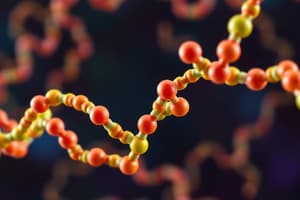Podcast
Questions and Answers
What is a key function of peptide bonds in protein synthesis?
What is a key function of peptide bonds in protein synthesis?
- Serving as a molecular framework for protein synthesis (correct)
- Mediating enzymatic reactions
- Participating in communication pathways
- Providing mechanical strength in cells
How does the structure of peptide bonds differ from simpler covalent bonds?
How does the structure of peptide bonds differ from simpler covalent bonds?
- Peptide bonds have a higher melting point
- Peptide bonds exhibit planarity (correct)
- Peptide bonds are stronger
- Peptide bonds are more flexible
Which step is involved in the formation of peptide bonds?
Which step is involved in the formation of peptide bonds?
- Interaction with lipids
- Removal of a nitrogen molecule
- Binding of hydrogen and oxygen groups
- Addition of a water molecule during dehydration synthesis (correct)
How do some proteins use peptide bonds in enzymatic reactions?
How do some proteins use peptide bonds in enzymatic reactions?
What characteristic of peptide bonds results from the sharing of valence electrons between carbon and nitrogen atoms?
What characteristic of peptide bonds results from the sharing of valence electrons between carbon and nitrogen atoms?
Which role do peptide bonds play in cellular communication pathways?
Which role do peptide bonds play in cellular communication pathways?
What is the primary role of peptide bonds in proteins?
What is the primary role of peptide bonds in proteins?
How do peptide bonds differ from simple covalent bonds?
How do peptide bonds differ from simple covalent bonds?
Why are peptide bonds considered indispensable in living organisms?
Why are peptide bonds considered indispensable in living organisms?
What atoms are involved in the formation of a peptide bond?
What atoms are involved in the formation of a peptide bond?
How do peptide bonds provide a stable scaffold for secondary protein structures?
How do peptide bonds provide a stable scaffold for secondary protein structures?
Which type of forces are responsible for shaping proteins, while the peptide backbone remains constant?
Which type of forces are responsible for shaping proteins, while the peptide backbone remains constant?
Flashcards are hidden until you start studying
Study Notes
Peptide Bonds: Foundational Molecular Linkages of Life's Building Blocks
Peptides, made up of amino acids joined by covalent bonds known as peptide bonds, serve as the backbone of proteins—molecules responsible for countless biological processes within living organisms. Understanding their role is pivotal because they directly impact the structure, function, and behavior of proteins. In this exploration, we will delve into the significance of peptide bonds and differentiate them from other types of chemical bonds while highlighting their various purposes, mechanisms of formation, and structural properties.
Importance of Peptide Bond:
Since the primary structure of proteins relies solely upon the sequence of amino acid residues linked through peptide bonds, these linkages play a fundamental role in determining protein folding patterns, stability, solubility, and subsequent functionality. This makes it indispensable across all forms of life. As proteins take shape via interactions between noncovalent forces like hydrogen bonding and van der Waals forces, the peptide backbone remains constant, providing a stable scaffold upon which secondary structures form.
Peptide Bond versus Other Chemical Bonds:
Unlike simple covalent bonds formed between two atoms, peptide bonds involve three atoms: one nitrogen atom from the carboxyl group (-COOH) of one amino acid, one carbon atom from the carbonyl group (-C=O) of another amino acid, and a single oxygen atom shared among both groups. Although similar, this arrangement distinguishes peptide bonds structurally from simpler covalent bonds found in molecules such as oxygen gas (O₂), water (H₂O), and methane (CH₄).
Functions of Peptide Bond:
- Providing molecular framework for protein synthesis: Through the formation of peptide bonds, individual amino acids link together to create polypeptide chains, which eventually fold into functional proteins. 2. Serving as structural elements: Protein domains composed of repetitive sequences of specific amino acids connected via peptide bonds offer cells mechanical strength, flexibility, and resistance to external stresses. 3. Mediating enzymatic reactions: Some proteins contain active sites where substrates bind, facilitating catalytic transformations according to their unique structures defined by peptide bonds. 4. Participating in communication pathways: Signal transduction occurs due to specific proteins interacting with each other based on spatial arrangements determined by the peptide backbone.
Formation of Peptide Bonds:
The formation of peptide bonds involves two principal steps: the removal of a water molecule during dehydration synthesis and the binding of amine and carboxylic acid groups. Enzymes called peptidases facilitate the process, helping secure proper connections between amino acids.
Structure of Peptide Bond:
In its simplest description, the peptide bond connects the alpha carbon of one amino acid to the nitrogen of the adjacent amino acid's amino group. Due to the presence of nitrogen's lone pair of electrons and the partial double bond character (sp² hybridization) resulting from the sharing of six valence electrons between carbon and nitrogen atoms, peptide bonds exhibit planarity perpendicular to the main chain direction.
Understanding the fundamental aspects of peptide bonds and their roles provides unparalleled insights into cellular functions, biochemistry, pharmacology, and medicine. Knowledge in this area also impacts the development of new technologies based on synthetic peptides, bioactive compounds, drugs, and gene therapy strategies.
Studying That Suits You
Use AI to generate personalized quizzes and flashcards to suit your learning preferences.




